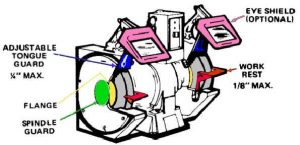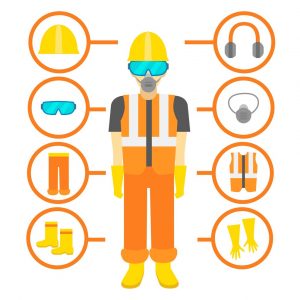HAND & POWER TOOL SAFETY
We sometimes take hand tools for granted. 
Household jobs usually are light, so you sometimes can get away with using tools improperly or substituting one tool for another. Our work, however, makes for rugged demands on tools. If we misuse a tool, or use one that’s wrong for the job or in poor condition, it can result in injury or spoiled work.
CHOOSE THE RIGHT TOOL FOR THE JOB
Would you use an axe to drive nails? Obviously not. You’d use a claw hammer. It’s the less obvious misuse of tools that gives us the most trouble, like using a screwdriver or a file as pry bar. Trouble also comes from trying to get by with a tool that’s not the right size for the job. A common mistake is using a wrench that’s the wrong size for the nut, or one with a handle that’s too short. This can result in scraped knuckles or a broken wrench.
How many times have you seen a person slip a cheater pipe over a wrench handle for more leverage on a tight nut? In many cases, the cheater pipe slips off the handle and the worker loses his balance and falls. And often it’s off a ladder. Don’t take chances. Get the right tool, even if it takes you a few minutes longer. You will most likely save yourself lost time and pay.
USE ONLY TOOLS IN GOOD CONDITION
Sometimes the hammer whose head comes off is less dangerous than the one whose head just wiggles a little. In the first case, we know the hammer is dangerous and fix it. In the second case, we never know when the head will twist enough to glance off the work, or just fly off.
Tools in proper condition have handles and heads that are sound and securely fitted; cutting edges that are sharp and true. It’s usually the dull tool that hurts you. Tools should be kept free of dirt and grease. If a tool doesn’t meet these qualifications, don’t use it. Otherwise, you’re asking for trouble.
USE TOOLS PROPERLY
Very few of us are experts when it comes to using every tool made. If you don’t know how to use a tool, don’t be afraid to ask someone who does. Here are a few tips for using tools safely and properly:
1. Pull a wrench. Don’t push.
2. Use the full handle of the hammer. If you choke up on it, you’ll lose control.
3. Always cut away from yourself.
4. Be sure to wear eye protection if there’s any chance of chips or flying particles.
5. Don’t use a file without a handle.
6. Don’t use a chisel or screwdriver as a pry bar.
CARRY AND STORE TOOLS SAFELY
If you carry tools in your hands, keep sharp or cutting edges covered and hold them away from you.
Use a tool box or belt when you carry a lot of tools. Don’t stuff them in your pockets. Keep the tool box orderly so you can easily find the tool you need without getting cut or gouged.
If your buddy wants to borrow one of your tools, hand it to him; don’t toss it.
Hand tool safety depends on the right tool for the job – in proper condition – used correctly – and carried and stored safely.
POWER TOOL SAFETY
Tools may be powered by electricity, compressed air, hydraulics, belts or chain drives. Power used by tools to do work can possess a tremendous amount of energy that must be controlled by the worker using the tool. Hazards from tool power sources affect not only the person using it, but also to those working close by.
POWER TOOL PRECAUTIONS
Equipment:
Make sure you know how to use any video equipment or that someone else is available to do so.
Power tools can be hazardous when improperly used. There are several types of power tools, based on the power source they use: electric, pneumatic, liquid fuel, hydraulic, and powder-actuated.
• Never carry a tool by the cord or hose.
• Never yank the cord or the hose to disconnect it from the receptacle.
• Keep cords and hoses away from heat, oil, and sharp edges.
• Disconnect tools when not in use, before servicing, and when changing accessories such as blades, bits and cutters.
• All observers should be kept at a safe distance away from the work area.
• Secure work with clamps or a vise, freeing both hands to operate the tool.
• Avoid accidental starting. The worker should not hold a finger on the switch button while carrying a plugged-in tool.
• Tools should be maintained with care and should be kept sharp and clean for the best performance. Be sure to follow instructions in the user’s manual for lubricating and/or changing accessories.
• Always make sure you keep good footing and maintain a good balance.
SUPERVISORS
Almost every employee uses some type of tool during the day to accomplish tasks. Whether it’s a screwdriver or jack hammer, your role as a supervisor is to ensure, that the tools used for each job, are the right tools for that job. This includes making sure tools are used safely and are in good working condition.
CHECK FOR DAMAGE
Look at handles, tool edges, power cords, hoses & connections, switches, triggers, casings and attachments. Check hand tools for cracks dings and chips. Don’t use damaged tools. Generally, hand tools cannot be repaired and should be thrown away. Power tools should not be jury rigged to work. Have repairs made only by someone who knows the tool repair craft.
PERSONAL PROTECTIVE EQUIPMENT
Almost all hand or power tool use requires wearing eye protection. If dust, fumes or mists are produced, the proper respirator must also be worn. Using gloves with powered equipment may be a hazard if there is a chance of the glove material getting caught in the equipment or material being worked.
CLOTHING HAZARDS

Long draping sleeves, baggy shirts, floppy pant legs are hazardous around powered equipment. Long hair should be pulled back so that it does not hang in front of the ears. All personal jewelry such as rings, necklaces and pendants should be removed before operating powered tools or equipment.
